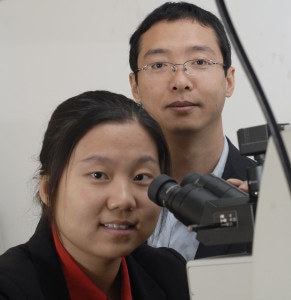Oct 14 2016
 Missouri S&T professors Jie Gao, left, and Xiaodong Yang say their 3-D holographic images could be used in biomedical imaging, security marking and big-data storage. Credit: Missouri University of Science and Technology
Missouri S&T professors Jie Gao, left, and Xiaodong Yang say their 3-D holographic images could be used in biomedical imaging, security marking and big-data storage. Credit: Missouri University of Science and Technology
A new approach to reconstruct 3D full-color holographic images with the help of only a single layer of nanoscale metallic film is being developed by researchers at Missouri University of Science and Technology. This new invention has the potential to change daily lives by equipping cell phones with 3D floating displays and providing credit cards with 3D printed security marking.
Dr. Xiaodong Yang, an assistant professor in mechanical and aerospace engineering at Missouri S&T, and Dr. Jie Gao, an assistant professor of mechanical and aerospace engineering at Missouri S&T, explain their ultrathin full-color holograms in “ACS Nano.”
They demonstrate their work by reproducing a number of full-color holographic images with thin films of nanometer-scale aluminum.
The “ACS Nano” article titled “Full-Color Plasmonic Metasurface Holograms” describes a method involving the use of ultrathin nanometer-scale metallic films with metasurfaces capable of controlling the wavefront of light. The metasurface hologram developed by the researchers is one 35-nanometer thick aluminum film punctured with extremely small rectangular holes of 160 nanometers by 80 nanometers with varied orientation angles produced by a microfabrication process called focused ion beam milling.
The researchers experimented with the interplay of blue, green and red light on metasurface structures in order to demonstrate “clean and vivid full-color holographic images with high resolution and low noise.” The three primary colors, red, green and blue, were produced, and secondary colors of white, yellow, magenta and cyan were also produced.
The researchers further developed “CMYW” letters, a Rubik’ cube, and an apple to illustrate the holographic images that were reconstructed. They believe that the metasurface hologram will be promising for future applications, such as big-data storage, 3D floating displays, biomedical imaging and credit card security marking.
By adjusting the orientation angle of the nanoscale slits, we are able to fully tune the phase delay through the slit for realizing the phase modulation within the entire visible color range. In addition, the amplitude modulation is achieved by simply including or not including the slit. Our holograms contain both amplitude and phase modulations at nanometer scale so that high resolution and low noise holographic images can be reconstructed.
Dr. Xiaodong Yang, Assistant Professor, Missouri University of Science and Technology
The metasurface hologram was developed by drilling out very small rectangular slits with different orientation angles through the aluminum thin layer. The hologram appears to be like a needlepoint pattern when observed under a scanning electron microscope.
Different from the currently existing metasurface holograms which are mostly designed for limited colors, our wavelength-multiplexed method — by encoding additional phase shifts into the holograms and introducing tilted incident angle illumination of laser light - results in the successful reconstruction of almost all visible colors.
Dr, Jie Gao, Assistant Professor, Missouri University of Science and Technology